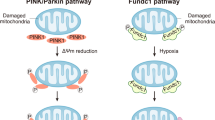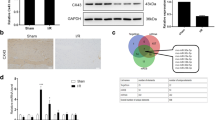Abstract
Mitophagy is one of the important targets for the prevention and treatment of myocardial ischemia/reperfusion injury (MIRI). Moderate mitophagy can remove damaged mitochondria, inhibit excessive reactive oxygen species accumulation, and protect mitochondria from damage. However, excessive enhancement of mitophagy greatly reduces adenosine triphosphate production and energy supply for cell survival, and aggravates cell death. How dysfunctional mitochondria are selectively recognized and engulfed is related to the interaction of adaptors on the mitochondrial membrane, which mainly include phosphatase and tensin homolog deleted on chromosome ten (PTEN)-induced kinase 1/Parkin, hypoxia-inducible factor-1 α/Bcl-2 and adenovirus e1b19k Da interacting protein 3, FUN-14 domain containing protein 1 receptor-mediated mitophagy pathway and so on. In this review, the authors briefly summarize the main pathways currently studied on mitophagy and the relationship between mitophagy and MIRI, and incorporate and analyze research data on prevention and treatment of MIRI with Chinese medicine, thereby provide relevant theoretical basis and treatment ideas for clinical prevention of MIRI.
Similar content being viewed by others
References
Hu SS, Gao RL, Liu LS, et al. Summary of the 2018 report on cardiovascular diseases in China. Chin Circ J (Chin) 2019;34:209–220.
Zhao J, Gao JL, Zhu JX, et al. The different response of cardiomyocytes and cardiac fibroblasts to mitochondria inhibition and the underlying role of STAT3. Basic Res Cardiol 2019;114:12–28.
Davidson SM, Arjun S, Basalay MV, et al. The 10th Biennial Hatter Cardiovascular Institute workshop: cellular protection-evaluating new directions in the setting of myocardial infarction, ischaemic stroke, and cardiooncology. Basic Res Cardiol 2018;113:43–54.
Wang J, Zhou H. Mitochondrial quality control mechanisms as molecular targets in cardiac ischemia-reperfusion injury. Acta Pharm Sin B 2020;10:1866–1879.
Kluge MA, Fetterman JL, Vita JA. Mitochondria and endothelial function. Circ Res 2013;112:1171–1188.
Ikeda Y, Sciarretta S, Nagarajan N, et al. New insights into the role of mitochondrial dynamics and autophagy during oxidative stress and aging in the heart. Oxid Med Cell Longev 2014;2014:210934.
Belgareh-Touze N, Cavellini L, Cohen MM. Ubiquitination of ERMES components by the E3 ligase Rsp5 is involved in motophagy. Autophagy 2017;13:114–132.
Wu Q, Luo CL, Tao LY. Dynamin-related protein 1 (Drp1) mediating mitophagy contributes to the pathophysiology of nervous system diseases and brain injury. Histol Histopathol 2017;32:551–559.
Chen G, Han Z, Feng D, et al. A regulatory signaling loop comprising the PGAM5 phosphatase and CK2 controls receptor-mediated mitophagy. Mol Cell 2014;54:362–377.
Tahrir FG, Langford D, Amini S, et al. Mitochondrial quality control in cardiac cells: mechanisms and role in cardiac cell injury and disease. J Cell Physiol 2019;234:8122–8133.
Zhou H, Ma Q, Zhu P, et al. Protective role of melatonin in cardiac ischemia-reperfusion injury: from pathogenesis to targeted therapy. J Pineal Res 2018;64:e12471.
Truban D, Hou X, Caulfield TR, et al. PINK1, Parkin, and mitochondrial quality control: what can we learn about Parkinson’s disease pathobiology? J Parkinsons Dis 2017;7:13–29.
Hirota Y, Kang D, Kanki T. The physiological role of mitophagy: new insights into phosphorylation events. Int J Cell Biol 2012,2012:354914.
Jin SM, Lazarou M, Wang C, et al. Mitochondrial membrane potential regulates PINK1 import and proteolytic destabilization by PARL. J Cell Biol 2010;191:933–942.
Okatsu K, Koyano F, Kimura M, et al. Phosphorylated ubiquitin chain is the genuine Parkin receptor. J Cell Biol 2015;209:111–128.
Geisler S, Holmström KM, Skujat D, et al. PINK1/Parkin-mediated mitophagy is dependent on VDAC1 and p62/SQSTM1. Nat Cell Biol 2010;12:119–131.
Gerald D. Parkin-dependent mitophagy in the heart. J Mol Cell Cardiol 2016;95:42–49.
Sun T, Ding W, Xu T, et al. Parkin regulates programmed necrosis and myocardial ischemia/reperfusion injury by targeting cyclophilin-D. Antioxid Redox Signal 2019;31:1177–1193.
Zhou H, Du W, Li Y, et al. Effects of melatonin on fatty liver disease: the role of NR4A1/DNA-PKcs/p53 pathway, mitochondrial fission, and mitophagy. J Pineal Res 2017:e12450.
Zhou H, Wang S, Hu S, et al. ER-mitochondria microdomains in cardiac ischemia-reperfusion injury: a fresh perspective. Front Physiol 2018;9:755–768.
Chu HX, Jones NM. Changes in hypoxia-induciblc factor-1 (HIF-1) and regulatory prolyl hydroxylasc (PHD) enzymes following hypoxic-ischemic injury in the neonatal rat. Neurochem Res 2016;41:515–522.
Wu H, Huang S, Chen Z, et al. Hypoxia-induced autophagy contributes to the invasion of salivary adenoid cystic carcinoma through the HIF-1 α/BNIP3 signaling pathway. Mol Med Rep 2015;12:6467–6474.
Rikka S, Quinsay MN, Thomas RL, et al. BNIP3 impairs mitochondrial bioenergetics and stimulates mitochondrial turnover. Cell Death Differ 2011;18:721–731.
Dhingra A, Jayas R, Afshar P, et al. Ellagic acid antagonizes Bnip3-mediated mitochondrial injury and necrotic cell death of cardiac myocytes. Free Radic Biol Med 2017;112:411–422.
Vasagiri N, Kutala VK. Structure, function, and epigenetic regulation of BNIP3: a pathophysiological relevance. Mol Biol Rep 2014;41:7705–7714.
Ncy PA. Mitochondrial autophagy: origins, significance and role of BNIP3 and NIX. Biochim Biophys Acta 2015;1853:2775–2783.
Shi RY, Zhu SH, Li V, et al. BNIP3 interacting with LC3 triggers excessive mitophagy in delayed neuronal death in stroke. CNS Neurosci Ther 2014;20:1045–1055.
Zhou H, Zhu P, Wang J, et al. Pathogenesis of cardiac ischemia reperfusion injury is associated with CK2 α -disturbed mitochondrial homeostasis via suppression of FUNDC1-related mitophagy. Cell Death Differ 2018;25:1080–1093.
Zhang W, Ren H, Xu C, et al. Hypoxic mitophagy regulates mitochondrial quality and platelet activation and determines severity of I/R heart injury. Elife 2016;5:e21407.
Zhou H, Wang J, Zhu P, et al. NR4A1 aggravates the cardiac microvascular ischemia reperfusion injury through suppressing FUNDC1-mediated mitophagy and promoting Mff-required mitochondrial fission by CK2α. Basic Res Cardiol 2018;113:23–43.
Wu D, Hu Q, Tan B, et al. Amelioration of mitochondrial dysfunction in heart failure through S-sulfhydration of Ca2+/calmodulin-dependent protein kinase II. Redox Biol 2018;19:250–262.
Eiringhaus J, Herting J, Schatter F, et al. Protein kinase/phosphatase balance mediates the effects of increased late sodium current on ventricular calcium cycling. Basic Res Cardiol 2019;114:13–27.
Zhou H, Li D, Zhu P, et al. Melatonin suppresses platelet activation and function against cardiac ischemia/reperfusion injury via PPAR gamma/FUNDC1/mitophagy pathways. J Pineal Res 2017;63:e12438.
Kulek AR, Anzell A, Wider JM, et al. Mitochondrial quality control: role in cardiac models of lethal ischemia-reperfusion injury. Cells 2020;9:214–250.
Zhang Y, Wang Y, Xu J, et al. Melatonin attenuates myocardial ischemia-reperfusion injury via improving mitochondrial fusion/mitophagy and activating the AMPK-OPA1 signaling pathways. J Pineal Res 2019;66:e12542.
Sciarretta S, Maejima Y, Zablocki D, et al. The role of autophagy in the heart. Annu Rev Physiol 2018;80:1–26.
Forini F, Nicolini G, Kusmic C, et al. Protective effects of euthyroidism restoration on mitochondria function and quality control in cardiac pathophysiology. Int J Mol Sci 2019;20:3377–3397.
Boyman L, Karbowski M, Lederer WJ. Regulation of mitochondrial ATP production: Ca2+ signaling and quality control. Trends Mol Med 2020;26:21–39.
Kundu M, Lindsten T, Yang CY, et al. Ulk1 plays a critical role in the autophagic clearance of mitochondria and ribosomes during reticulocyte maturation. Blood 2008;112:1493–1502.
Kubli DA, Zhang X, Lee Y, et al. Parkin protein deficiency exacerbates cardiac injury and reduces survival following myocardial infarction. J Biol Chem 2013;288:915–926.
Matsui Y, Takagi H, Qu X, et al. Distinct roles of autophagy in the heart during ischemia and reperfusion: roles of AMP-activated protein kinase and Beclin1 in mediating atutophagy. Circ Res 2007;100:914–922.
Anzell AR, Maizy R, Przyklenk K, et al. Mitochondrial quality control and disease: insights into ischemia-reperfusion injury. Mol Neurobiol 2018;55:2547–2564.
Zhou H, Zhang Y, Hu S, et al. Melatonin protects cardiac microvasculature against ischemia/reperfusion injury via suppression of mitochondrial fission-VDAC1-HK2-mPTP-mitophagy axis. J Pineal Res 2017;63:e12413.
Zhou H, Zhu P, Wang J, et al. Pathogenesis of cardiac ischemia reperfusion injury is associated with CK2 α -disturbed mitochondrial homeostasis via suppression of FUNDC1-related mitophagy. Cell Death Differ 2018;25:1080–1093.
Hu F, Rong YL, Zhu KY, et al. Study on the protective effect of Guanxinning Tablet on myocardial ischemia reperfusion injury in rats. Chin J Comp Med (Chin) 2017;27:76–82.
Guo YQ, Xue RW, Wu W, et al. The protective effect of Guanxinning Injection post-treatment on myocardial ischemia-reperfusion injury. J Clin Cardiol 2020;36:161–165.
Peng F, Yuan M, Qiu YF, et al. Clinical observation on the protective effect of Shenmai post-treatment on myocardial ischemia and reperfusion. Chin Tradit Med Sci Tech (Chin) 2013,20:384–385.
Lin X. Clinical observation on the treatment of myocardial ischemia and reperfusion injury by Danshen Lyophilized. Chin J Integr Med Cardio-Cerebrovasc Dis (Chin) 2013,11:164–165.
Shi GJ, Li YX, Shi HN, et al. Clinical observation on the effect of Tongluo Dingtong Capsule on plasma TNF-α and ICAM-1 in myocardial ischemia reperfusion injury. Med J Chin People’s Health (Chin) 2008;9:894–896.
He YH, Chen JH, Liang JQ, et al. The clinical observation on Kaixin Capsule for ischemia reperfusion injury after acute myocardial infarction, the syndrome of blood stasis due to deficiency of qi in traditional Chinese medicine. J Emerg Tradit Chin Med (Chin) 2005;12:1137–1139.
Xie LD, Liu Y, Zhou K, et al. Superficial view on traditional Chinese medicine pathogenesis of myocardial ischemia reperfusion injury. Chin J Tradit Chin Med Pharm (Chin) 2015;30:3139–3141.
Yang HX, Wang P, Wang NN, et al. Tongxinluo ameliorates myocardial ischemia-reperfusion injury mainly via activating parkin-mediated mitophagy and downregulating ubiquitin-proteasome system. Chin J Integr Med 2021;27:542–550.
Zhang DW. Effects of Yimai Granules regulating mitophagy on myocardial injury in rats with high fat and MIRI [dissertation]. Shenyang: Liaoning University of Chinese Medicine; 2019.
Xin GJ. Study on the mechanism of Shuangshen Ningxin Capsule regulating FUNDC1 mediated mitochondrial autophagy to protect myocardial schemia-reperfusion injury [dissertation]. Beijing: China Academy of Chinese Medical Sciences; 2020.
Sun H, Liu K, Cai GF, et al. Discussion on the myocardial protective effect and mechanism of Baijin Decoction on MIRI rats based on mitophagy. Lishizhen Med Mater Medica Res (Chin) 2020;31:539–542.
Li X. Study on mechanism of Gualou Xiebai Banxia Decoction on the mitophagy and PINK1/Parkin pathway in rats with myocardial ischemia reperfusion injury [dissertation]. Kunming: Yunnan University of Traditional Chinese Medicine; 2020.
Liu XW, Lu MK, Zhong HT, et al. Panax Notoginseng Saponins attenuate myocardial ischemia-reperfusion injury through the HIF-1 α/BNIP3 pathway of autophagy. J Cardiovasc Pharmacol 2019;73:92–99.
Zhu N, Cao X, Hao P, et al. Berberine attenuates mitochondrial dysfunction by inducing autophagic flux in myocardial hypoxia/reoxygenation injury. Cell Stress Chaperones 2020;25:417–426.
Zhu N, Li J, Li Y, et al. Berberine protects against simulated ischemia/reperfusion injury-induced H9C2 cardiomyocytes apoptosis in vitro and myocardial ischemia/reperfusion-induced apoptosis in vivo by regulating the mitophagy-mediated HIF-1 α/BNIP3 pathway. Front Pharmacol 2020;11:367.
Blackstone NW. The impact of mitochondrial endosymbiosis on the evolution of calcium signaling. Cell Calcium 2015;57:133–139.
Saraste M. Oxidative phosphorylation at the fin de siecle. Science 1999;283:1488–1493.
Tang Q, Cao Y, Xiong W, et al. Glycyrrhizic acid exerts protective effects against hypoxia/reoxygenation-induced human coronary artery endothelial cell damage by regulating mitochondria. Exp Ther Med 2020;20:335–342.
Yim TK, Ko KM. Schisandrin B protects against myocardial ischemia-reperfusion injury by enhancing myocardial glutathione antioxidant status. Mol Cell Biochem 1999;196:151–156.
Lu CQ, Jia HL, Zhen L, et al. Schisandrin B alleviates myocardial ischemia/reperfusion injury via maintaining mitophagy. Acta Univ Med Anhui (Chin) 2019;54:418–422, 428.
Author information
Authors and Affiliations
Contributions
Xia JY drafted the manuscript. Li D and Lin Q helped the conception of design strategies. Chen C coordinated all manuscript and collected the data. Wan J, Li Y and Cui J revised the manuscript. All authors reviewed and approved the final manuscript.
Corresponding author
Ethics declarations
The authors declare that they have no competing interests.
Additional information
Supported by the Beijing University of Chinese Medicine Research and Innovation Team Project (No. 2019-JYB-TD-08) and Youth Science Fund Project of National Natural Science Foundation of China (No.81803906)
Electronic supplementary material
Rights and permissions
About this article
Cite this article
Xia, Jy., Chen, C., Lin, Q. et al. Role of Mitophagy in Myocardial Ischemia/Reperfusion Injury and Chinese Medicine Treatment. Chin. J. Integr. Med. 29, 81–88 (2023). https://doi.org/10.1007/s11655-021-3301-1
Accepted:
Published:
Issue Date:
DOI: https://doi.org/10.1007/s11655-021-3301-1




